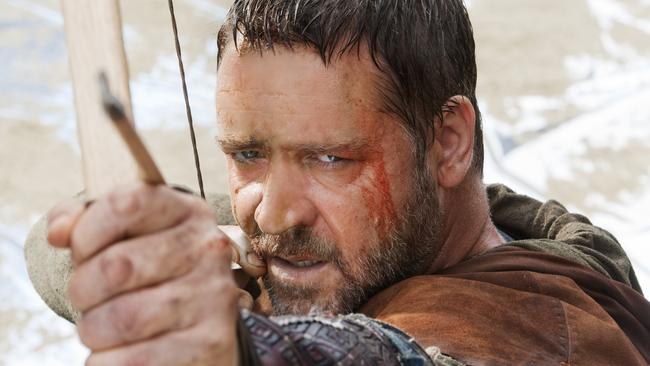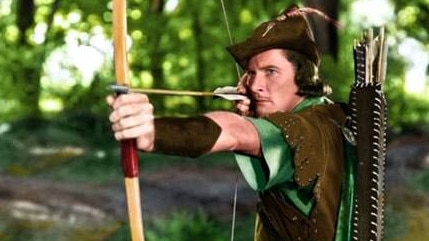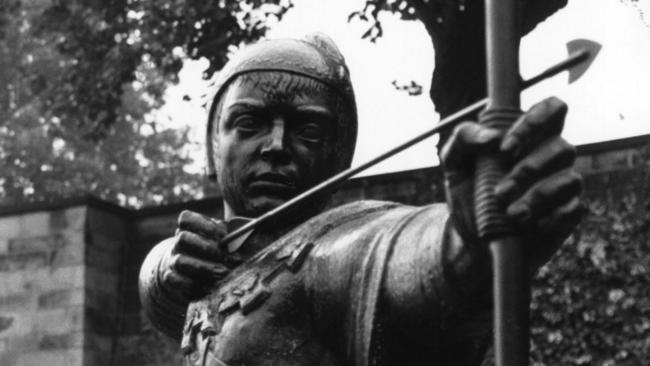Real Robin Hood may have been more petty thief than heroic outlaw
Hollywood loves to remake the legend of Robin Hood, with yet another reimaging due out this week. But for all his popularity the man himself remains surprisingly elusive
- Emma Thompson rules in compelling grown-up drama
- William Goldman, Oscar winner for ‘Butch Cassidy,’ has died
Hollywood loves men in tights and every five-10 years it produces a new big-screen interpretation of the legend of Robin Hood. In 2010 Russell Crowe starred as a rather grizzled version of the outlaw in Robin Hood and this week it is the turn of a more fresh-faced Taron Egerton to pick up the bow and arrows in yet another re-imagining with the same title.
Both films draw on legends going back to at least the 13th century, when Robin made his first appearances in ballads performed by wandering storytellers and minstrels. While there have been many variations in the tales across time, all focus on a man who falls foul of the king’s law keepers, for varying reasons, including illegally hunting in the royal forests or for daring to stand up against local representatives of the king.

Declared an outlaw he goes on the run, hiding in a forest, emerging only to rob the rich to give to the poor, to fight against unjust laws and taxes. In some stories he comes out of hiding, in disguise, to take part in an archery competition, displaying an almost superhuman talent for firing arrows and taking the prize from under the noses of the king’s men.
For historians the real Robin remains elusive.
There are records of a petty thief turned outlaw named Robert Hod at the York Assizes (a periodical court session) in July 1225, who later escaped into the woods, but it is impossible to say whether he inspired the legend.
Another record mentions William son of Robert Le Fevre, indicted in 1261 for larceny and harbouring thieves, who is later called William Robehod.
The first clear written reference to Robin is in the narrative poem Piers Plowman, by William Langland, believed to have been written in about 1370. Langland doesn’t give any details of the life of the outlaw but his narrator says he can recite poems about “Robyn Hood”, meaning that Robin was already part of literary tradition.
In the Scotichronicon, a chronicle of Scottish history written between 1377 and 1450, it says in 1226 “there arose the famous cutthroat Robin Hood as well as Little John, together with their accomplices from among the disinherited.” It also mentions him fighting against a “sheriff” of the king. The 14th century was a popular time for ballads about men who challenged the authority of the king’s officers.

Many early ballads set the action of the story in Yorkshire rather than Nottinghamshire, perhaps inspired by real people such as the Robert Hod in the York Assizes. But like many fugitives, the real criminal was romanticised and turned into poems, songs and plays.
The earliest legends turning criminals into heroes may have drawn inspiration from veterans of the Crusades, both soldiers and nobles, who fought against the tyranny of England’s King John and his taxes at the beginning of the 13th century, after the death of his brother, Richard I.
One such nobleman was Fulk Fitz Warin whose lands had been confiscated by John and who turned outlaw in 1200 only to be pardoned and then to take part in the 1215 rebellion against the monarch.
In the 14th century, the era of the 1381 Peasant Revolt, the Robin Hood ballads reflected the fight by yeomen (small free landholders, merchants
and artisans) and peasants fighting against unjust taxation, which they believed was imposed by the king’s corrupt advisers.
Robin was later melded with other historical outlaws, such as Friar Tuck, who is mentioned as “Frere Tuck” in writs issued for his arrest in 1417.

A later letter reveals Tuck’s identity as Robert Stafford, a Sussex chaplain. He became part of the Robin Hood legend in 1475 in a ballad called Robin Hood And The Monk. It was not until John Major’s 1521 History Of Greater Britain that Robin is first mentioned as a follower of King Richard I, something that became a regular feature of later stories.
In the 16th and 17th century stories often also depicted Robin as a noble fallen from grace who fights King John’s forces and helps the poor while trying to recapture his inheritance.
Anthony Munday’s play The Downfall And The Death Of Robert Earl Of Huntington, published in 1601, identified him with the Earl of Huntington, who served in the Crusades and also took part in a siege of Nottingham Castle.
In the 18th century antiquarians collected the ballads, poems and tales and tried to place Robin in history.
In the 19th century authors wove Robin into works of fiction, such as Howard Pyle, in his 1883 The Merry Adventures of Robin Hood, and Sir Walter Scott’s Ivanhoe. But the real Robin remains slippery, perhaps the reason he is so regularly reinvented.



